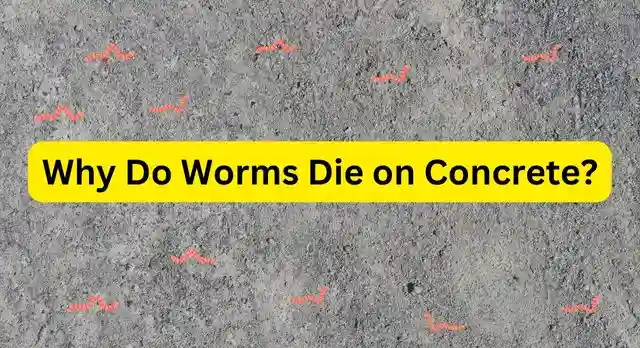Why Do Worms Die on Concrete? The Mystery Unveiled
Have you ever wondered why worms often meet an unfortunate fate on concrete surfaces? The sight of dead worms on sidewalks and driveways may leave you puzzled. In this article, we will explore the reasons behind the mortality of worms on concrete and uncover the unique challenges they face in this unfamiliar environment. Let’s dive into the world of worms and shed light on the mystery of why they perish on concrete surfaces.
Why Do Worms Die on Concrete?
Worms, typically found thriving in the moist and nutrient-rich soil, face a multitude of challenges when they venture onto concrete. Let’s delve into the key factors contributing to their mortality on these unforgiving surfaces.

1. Lack of Moisture and Dehydration
One of the primary reasons worms die on concrete is the lack of moisture. Concrete surfaces are dry, lacking the necessary moisture that worms rely on for their survival. As worms respire through their skin, moisture is essential to keep their bodies moist. When they encounter concrete, the porous material absorbs the moisture from their bodies, leading to rapid dehydration. Without adequate moisture, worms cannot perform vital functions and eventually succumb to the harsh conditions.
2. Temperature Extremes
Concrete surfaces are known to exhibit extreme temperatures compared to their surrounding environment. When exposed to direct sunlight, concrete can become scorching hot, causing worms to overheat. On the other hand, during colder periods, the concrete’s temperature can drop significantly, subjecting worms to freezing conditions. The inability of worms to regulate their body temperature efficiently makes them vulnerable to these extreme temperature fluctuations, resulting in their demise.
3. Absence of Soil Environment
Worms are highly adapted to living in soil, which provides them with a nourishing environment filled with essential nutrients, microorganisms, and organic matter. When worms find themselves on concrete surfaces, they are deprived of these vital elements necessary for their survival. Concrete cannot provide the same level of nourishment and protection as soil, leading to their gradual decline and eventual death.
How to Clean Dead Worms off Concrete?
Cleaning dead worms off concrete can be a relatively simple process. Here’s how you can do it:
- Wait for the worms to dry out: Allow the dead worms to dry out naturally on the concrete surface. This will make them easier to remove without leaving behind any residue.
- Scrape the worms off: Once the worms have dried, use a stiff brush, scraper, or putty knife to gently scrape the dried worms off the concrete. Be careful not to scratch or damage the concrete surface while doing so.
- Sweep or vacuum the area: After removing the dead worms, sweep the area with a broom or use a vacuum cleaner to collect any remaining debris. Dispose of the dead worms and debris properly.
- Clean with water and mild detergent: If there are any stains or remnants left on the concrete, you can clean the area with a mixture of water and mild detergent. Use a scrub brush or sponge to gently scrub the stained area, then rinse with clean water.
- Allow the surface to dry: After cleaning, let the concrete surface air dry completely before using it again.
How to Help Worms on Concrete Surfaces?
While we cannot transform concrete into a suitable habitat for worms, we can take certain measures to assist them and minimize their mortality. Consider the following steps:
- Provide Moisture: If you come across worms on concrete, gently transfer them back to a moist environment, such as nearby soil or vegetation. This allows them to regain the necessary moisture levels and increase their chances of survival.
- Create Worm-Friendly Spaces: Design your outdoor spaces to include worm-friendly elements. Incorporate mulched areas, gardens, or flower beds that provide a moist and shaded environment, encouraging worms to stay within their preferred habitats.
- Educate and Raise Awareness: Share information about the challenges worms face on concrete surfaces and the importance of their role in ecosystems. Encourage responsible actions, such as avoiding unnecessary harm and taking steps to assist worms when encountered.
Conclusion
The mortality of worms on concrete surfaces can be attributed to factors such as lack of moisture, dehydration, temperature extremes, and the absence of a suitable soil environment. Concrete poses significant challenges for worms, leading to their unfortunate demise. However, by providing moisture, creating worm-friendly spaces, and raising awareness, we can contribute to mitigating their mortality and supporting their survival.
Let’s remember that worms play a vital role in maintaining soil health and nutrient cycling. By taking proactive steps to assist worms on concrete surfaces, we can show appreciation for their contributions to our ecosystems. Together, let’s strive to create a more harmonious coexistence between worms and urban environments, ensuring their well-being and the preservation of their valuable ecological roles.
